RIGHT TURN ONLY!!
Shana no Kiss
by Carlo Santos,

At the time I write this, Anime Expo hasn't happened yet.
By the time you read this, Anime Expo will be OVER!
I wonder what happens in the space between?
FAUST
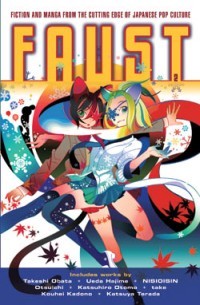
Vol. 2
(by various, Del Rey, $17.95)
FROM THE BACK COVER:
"A brilliant anthology featuring manga-inspired fiction from today's best writers with artwork from top manga creators, including:
'ECCO,' by Tatsuhiko Takimoto (illustrated by D.K): Is life nothing but a cruel joke? One young rebel decides to find out.
'Jagdtiger,' by Kouhei Kadono (illustrated by Ueda Hajime): She's a combat-ready synthetic human with a dangerous flaw: a heart.
'Where the Wind Blows,' by Otsuichi (illustrated by Takeshi Obata): A newspaper from the future carries a very disturbing story for one particular woman: she will die by the hand of the man she loves.
'Magical Girl Risuka,' by NISIOISIN (illustrated by Kinu Nishimura): She's a beautiful witch with magical powers that could change the world. And he's the boy who will give her a reason to do it.
'Gray-Colored Diet Coke' by Yūya Satō: He's nineteen, surrounded by morons, and desperate to escape his crummy part-time job. His best friend's plan worked great, but surely suicide can't be the only way out."
EVIDENCE FOR:
Thank goodness Faust only hits Western shores once a year or so, or people would need psychiatric care from all the mind-bending that goes on in this anthology. Japan's geek-generation writers strike gold once again, with NISOISIN's intricate murder-mystery leading the way (in 70 pages he is able to build an entirely new concept of magic) and Otsuichi (who brilliantly spoofed Doraemon last volume) bringing back a couple of characters to tell yet another arresting slice-of-life sci-fi. Can't go wrong with time travel, folks. Even Kouhei Kadono, who ran a rather "meh" entry last time, connects it to his new short story in surprising ways. And if it's not the properties of space and time that are being messed with, it's the hearts and minds of our young protagonists—Tatsuhiko Takimoto's emotionally draining "ECCO" proves that there's more to his literary talents than just Welcome to the N.H.K., while Yûya Satô channels Salinger in his vibrant portrait of teenage discontent. Even the shorter pieces and essays are fascinating in their own way—check out the interview and see how excited these authors are about being published in America.
EVIDENCE AGAINST:
Wait ... the same people again? And the same self-congratulatory back-patting where everyone tells each other how great Faust is? It's hard to imagine a cutting-edge literary anthology being formulaic and repetitive, but when the lineup is composed 80% of the same authors as last time, that kind of defeats the purpose of discovering crazy new stuff. Plus, with Kadono and Otsuichi both "recycling" certain characters, it becomes even more like serial light-novel fluff instead of groundbreaking modern work. Meanwhile, the jury's still out on the short essays—Kaichirō Morikawa's piece on licensed character goods is interesting but doesn't seem to have a point, while the "Counseling Sessions" seem more like incoherent geek rambling than actual spoofs of magazine columns. Hey, guys, save it for your blogs or something. Then there's the comics content, which is decidedly on the weak side after all the great storytelling going on in the left-to-right section of the book. Avant-garde, experimental, call it whatever you want—point is, there's really not enough page space to do justice to the manga section.
FINAL VERDICT:
As with any anthology, not every entry is an instant hit, but there's already so much good stuff that it gets an A- anyway.
KIMIKISS

Vol. 1
(by Taro Shinonome and Enterbrain Inc., Tokyopop, $10.99)
FROM THE BACK COVER:
"Kouichi may have started high school not having kissed a girl, but he sure as hell won't graduate that way!
Kouichi and Mao, best friends since childhood, head off to high school only to discover that they aren't the kids they used to be. Mao is a total babe with no problems attracting the opposite sex, while Kouichi ... well ... he could use a little help."
EVIDENCE FOR:
So, how do you adapt a dating sim into a romance manga without turning it into a tawdry harem series? The answer: split each of the different story paths so that the guy only falls in love with one girl at a time! Thus we get the sweet simplicity of Kimikiss, which in Volume 1 has our hero Kouichi falling for his childhood friend (and therefore the prettiest one in the franchise). The one-girl-at-a-time approach actually solves several of the genre's problems: there's no prolonged frustration for Kouichi, as he and Mao start courting pretty much from Day One, there are no ridiculous love polygons or misunderstandings to deal with, and the storyline is stripped clean of irritating gimmicks like having a lecherous best friend. (After all, why would you need love advice from other guys when you're already getting what you want?) And because the story is so focused on that one relationship, an unexpected benefit emerges: the kiss scenes are really, really, heart-meltingly cute. Maybe it's the idyllic backgrounds that do it, or the distinctively drawn characters—but first love really takes on a unique glow in this series.
EVIDENCE AGAINST:
This whole concept of splicing a romance game into the individual girls' storylines may sound like a good idea at first ... until you realize that the whole reason romantic stories are interesting is because there are obstacles in the way of the main couple. If Kouichi and Mao are going to make it all the way to the last chapter without anyone trying to get in the way of their undying love, then what's the point? Is there any sense of struggle and accomplishment if they get their first kiss within twenty pages and then coast to the finish line? Plus, this storytelling approach doesn't solve the real problems the usually irk people about male-targeted romances: gratuitous fanservice (in the guise of pointless undressing scenes and Mao's freakishly malformed chest), highly unrealistic female personalities (you seriously mean to tell me that a girl is just going to suddenly start coming on to her childhood friend like that?), and the use of contrived, predictable scenarios (school rooftop, walking home, public swimming pool, school festival). Following this story is like reading a walkthrough on how to win Mao in the game—and that's not entertainment.
FINAL VERDICT:
Admittedly, the simplicity of the story and the cute factor made me enjoy this more than I probably should have. So call it a B-, but the lack of conflict and typical cheesecake approach will turn off most others.
NIGHTMARE INSPECTOR: YUMEKUI KENBUN

Vol. 8
(by Shin Mashiba, Viz Media, $9.99)
FROM THE BACK COVER:
"For those who suffer nightmares, help awaits at the Silver Star Tea House, where patrons can order much more than just Darjeeling. Hiruko is a special kind of private investigator. He's a dream eater. And he'll rid you of your darkest visions ... for a price.
Dreams on the menu in this volume: a childhood friendship that has lost its innocence, Kairi caught up in his own delusion, a sinister trap set for a Baku, an inn with deadly secrets, a sea of drowned memories, a mother's forgotten item, a man confined to an elevator, and Hifumi's family affairs."
EVIDENCE FOR:
Once again, Nightmare Inspector is at its best when relying on the loopy properties of dream logic and bending readers' minds with unexpected twists. The first chapter is a classic example—a sequence of events defies the space-time continuum as everything appears to be happening at 6:57 pm—and things just get crazier from there. Mashiba's most effective tool is the narrative double-pump: execute one plot twist, and then just when everyone thinks they've got the mystery figured out, pull off another one! That's what happens in chapters like the one where a dreamer dies in her own dream (or did she?), or the case of a haunted inn where all the clues are coded into the blood-stained screen door, or where a repressed childhood memory about a death at sea has to be reconstructed piece by piece. But it's not just the careful concealments and revelations that energize this series; the moody visual atmosphere also plays a key role in Hiruko's investigations. With deeply-contrasting blacks and whites and Art Deco styling, this is a dreamworld that pulls you in as much with its artistry as with its mystery.
EVIDENCE AGAINST:
When it comes to horror-tinged mysteries, withholding information isn't such a bad thing. But when the time comes for that information to be presented, that's where this series constantly drops the ball. The elevator story, for example, just becomes a complete mess before it even hits the halfway mark (and also ruins a really interesting metaphor in the process). Even the highlights mentioned above—the dreamer who dies, the death at sea—have to wade through some highly confusing material in order to reach their dramatic conclusions. Most of it can be blamed on classic manga mistakes, like characters that are difficult to tell part, lines of dialogue that float around without having a clear speaker, and crowded layouts where a magnifying glass would be really handy in figuring out what's happening in the story. Then there are the times when nobody really cares about what's happening in the story anyway because it's one of those affairs involving the recurring characters instead of their clients: Kairi's demented flight of fantasy is uninteresting because it doesn't involve other people's nightmares, and the same with Hifumi's arranged-marriage dilemma. This kind of drivel is a nightmare itself.
FINAL VERDICT:
The stylish art and wicked twists would be far more enjoyable if the stories weren't so confusing to figure out. Sorry, only a C- for this one due to poor execution.
SHAKUGAN NO SHANA
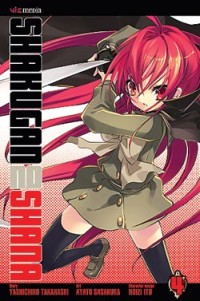
Vol. 4
(by Yashichiro Takahashi and Ayato Sasakura, Viz Media, $9.99)
FROM THE BACK COVER:
"Yuji Sakai is beginning what he thinks will be the life of a normal high school student. But everything changes when he is drawn into the struggle between creatures from another world, the Crimson Denizens, and a girl, Shana. He has a crucial role to play in the conflict, despite the fact that ... he's dead!
There's a sinister new Flame Haze in town by the name of Margery Daw, and soon she and Shana are in a fight to the death! Meanwhile Yuji runs into a strange old man named Lamies ... who reveals himself to be a most unusual Crimson Denizen indeed."
EVIDENCE FOR:
The conflict between entities of the spiritual world is what brings most fans to Shakugan no Shana, but when the main characters start having conflict within themselves ... that's when things really start getting interesting. Yuji losing his will to fight after a poor performance in a previous battle? Interesting. The knock-on effect of Shana getting all moody? Even more so. After all, this is the girl who's built her reputation on beating other people around—so when she starts beating up on herself, that's definitely a make-or-break story development. Things get even more intense when Margery Daw drags Shana into battle, because there's no handicap quite like having to fight in an emotionally weakened state. Not surprisingly, this confrontation is a multi-chapter affair that leaves off at the midpoint, because fighting for one's life is not something easily done in a single shot. The widely-spaced layouts and dramatic angles provide the perfect staging for the battle; it's absolutely essential that there be enough room for the pyrotechnics of Shana's swordplay and Margery's dark sorcery. As it turns out, even a "spiritual" conflict can feel as real and physical as an all-out brawl.
EVIDENCE AGAINST:
If the testing of Shana's emotional mettle is the good part, why does it take so long to get there? And for that matter, if Yuji's crisis of willpower is so fascinating, why isn't there more page space devoted to that? Over half of this book is taken up by far less interesting logistical matters, like Margery Daw mincing around town trying to find Lamies, or Yuji mincing around town trying to feel better about himself (and if hanging out with a cute girl doesn't do it for him, all hope is lost), or Lamies trying to explain why he behaves the way he does when it comes to the spirit world. Frankly, the world-building is one of the worst aspects of Shana; as soon as people start blabbering about Flame Hazes and torches, the Don't Care Meter just goes shooting straight up. It's really the character dynamics that drive this series, and there's just not enough of that in this volume. Plus, with the Margery-Shana battle starting so late, there's not enough action-adventure factor to compensate. This is a story arc headed in the right direction ... but focuses entirely on all the wrong material.
FINAL VERDICT:
Margery, Shana, why didn't you start fighting each other sooner? And you, Lamies, shut up and get to the point for once! It's a C for this block of well-meaning but misguided storytelling.
TAKERU: OPERA SUSANOH SWORD OF THE DEVIL
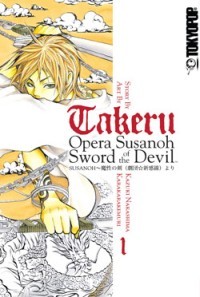
Vol. 1
(by Kazuki Nakashima and Karakarakemuri, Tokyopop, $10.99)
FROM THE BACK COVER:
"Three unlikely companions, all named Takeru, begin an epic quest across the land of Oyashima, in search of the powerful sword of Susanoh. Torn between the warring factions of Amamikado and the battle maidens of Jagara, Oyashima is a land of magic and disorder—and the treasure of the gods, the sword of Susanoh, may be the only way to restore balance to this chaotic land. But each Takeru has his own motives for seeking the sword..."
EVIDENCE FOR:
Wanna know how to get a good story going? Do an adaptation of a stage play. Yes, after anime, video games, visual novels, light novels, heavy novels, cell phone novels, there's pretty much nothing left but the theatrical arts, and Takeru translates to manga perfectly with its fanciful historical setting and high levels of action. Even though it relies on the standard epic-quest formula, the writing clearly surpasses that of standard pop entertainment: the three Takerus complement each other perfectly as archetypes of brains, brawn and luck, while the war that's raging in the background rings with a classic mythological feel, and the challenges they face are similarly epic in scope (especially the Three Tasks in the last chapter). Naturally, the swordfighting and hand-to-hand combat is absolutely electric, but so is the interplay between the main characters, as they go at each other with bright and snappy dialogue. The visual aspect also stands out, with striking historical costumes and battle action that often borders on ballet. Bold lines and unique character designs make this one a pleasure for the eyes, while the story's constant forward momentum should please the mind as well.
EVIDENCE AGAINST:
So, that's it? Bunch of guys chasing after a sword, so they team up with an amazon tribe to take on the world's greatest army? It seems that even the performing arts has succumbed to the lure of churning out predictable genre material. Pared down to its core, Takeru is basically a linear hack-and-slash with occasional folk-tale ripoff moments. This might make for great action and easily likable characters, but the depth of the story takes a pretty big hit, so much so that we know nearly nothing about the bad guys other than that they're ... bad. Everyone's just too busy watching Takeru and company being awesome. And even then, their acts of awesomeness are dampened by a lack of background art and the much-beloved "here's a battle move that's so amazing it's hard to tell exactly tell what it is" maneuver. Who knows, maybe it looked better on stage. As a fantasy work, this one seems to be going through the standard motions, just like ones adapted from more familiar sources.
FINAL VERDICT:
Sure, it could be better, but the way it is right now—with great action and great characters—it's still pretty good! Good enough to earn a B, at least.

PIXIE
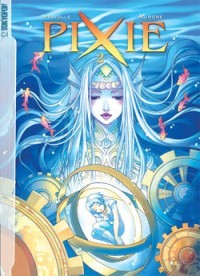
Vol. 2
(by Mathieu Mariolle and Aurore, Tokyopop, $12.99)
FROM THE BACK COVER:
"Science and magic clash in an unforgettable showdown in this thrilling conclusion to Pixie.
Ael, Balos, and Ervynn find themselves in way too deep—they've somehow plunged to the depths of the ocean, to where Ael has dreamed them. Meanwhile, back in the virgin forest, the pixies divulge a revelation about the mysterious city of Earis—a secret the Elazul elders have kept from the rest of the tribe.
Worlds hang in the balance and dreams become reality—and a hazardous quest begins to find a destructive machine that is fueled by the imaginations of its victims!"
EVIDENCE FOR:
It's often said that great creators are the ones who can bring a convincing fantasy world to life—but Pixie goes one better and weaves tales of multiple worlds, each one threaded into a grand, parallel-earth-shattering plot. With less confusion and a much more focused direction than the first volume, this finale is everything one could ask for in a fantasy epic: hot-blooded battles, split-second escapes, tragic sacrifices, and yes, a shade of romance here and there (most of which is addressed with tongue in cheek). At the same time, this story also manages to play its twists and surprises with great deftness—even long-forgotten little plot points are revisited and resolved in the ending. Then comes the finishing touch: the sheer artistic talent that's necessary to bring this tale to life. The oceanic world of Tidia is an absolute masterpiece of underwater blue, while the pixie forest shines in green, and the dystopian shades of Earis set the mood for the final showdown. Add in the striking character costumes, thrilling swordplay scenes, and an eye for dramatic layouts (isn't Ael's final dream magnificent?) and this becomes a true fantasy gem.
EVIDENCE AGAINST:
They try so hard to impress us with color art and multiple fantasy worlds, but somehow the fundamentals still go awry. I suppose it's in the French tradition to line up the panels all nice and rectangular, but for a truly dynamic effect, one really ought to try tilting the angles every now and then. Otherwise we get these awkward, boxed-in swordfights where the energy never quite breaks through. On a larger scale, there's also the issue of scene transitions, which seem to come in the oddest places and always require a few seconds of re-orientation to remember which world the characters are in. (The only places where this confusion doesn't occur are in the forest and the sea.) And the storyline itself, even though it does get more focused as things barrel toward the final battle, still suffers from Too Many Characters Syndrome and wacky fantasy names and subplots where you have to explain it to yourself while reading. Maybe something got lost in translation and the dialogue's not clear enough? Either way, Pixie seems to suffer under the weight of its own ambitions.
FINAL VERDICT:
The execution and story flow may be off at times, but it's still one hell of a ride—and the central idea, about a kid who can literally dream things to life, is right up there with anything Neil Gaiman's come up with.

Okay ... I'm still waiting for someone to send in a review of that one series they'd really like to see licensed! In the meantime, I'm going to dig back in the archives and pull out another "guilty pleasure" entry because that category seemed really popular for some reason. Here's Ceecee checking out a timeless manga classic (at least among the ladies) ...
SAIYUKI
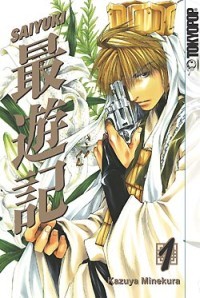
(by Kazuya Minekura, Tokyopop, $9.99 ea.)
My guilty pleasure? I'd have to say Saiyuki.
I'm not entirely sure what the general opinion of this series is because it doesn't seem to get discussed much—but it's probably my favorite manga despite its many faults. By no means is this a literary masterpiece, it's full of filler stuff and I have to say that if I'd read some of Kazuya Minekura's other work before this I would've dropped Saiyuki immediately because ALL HER CHARACTERS LOOK THE SAME. Seriously. I saw the cover of one of her other works and did a double take, wondering why Hakkai was there...
Now the story behind this is simple, it's based off of that book written ages ago in China that we all know and love. Yes, that one that Dragon Ball is based on. Anyways this Saiyuki massively redid the characters into typical Awesome Dudes. You have the hungry one, the angry one, the nice/scary thoughtful one, and the perverted one. The premise is pretty cool: before, the youkai and humans coexisted peacefully—but for some reason the Minus Wave spread throughout Shangri-La and turned all the youkai primal, and now they eat humans and enjoy carnage. The four boys were picked by the Three Aspects (high religious people) to go and find the cause and stop it. The priest because of his inherent power, and the three because all are youkai-but-not, and so haven't been affected by the wave.
Nonetheless it's a thoroughly enjoyable series. The author spends alot of time spewing out awesome-sounding one-liners and throwing the characters into pseudo-yaoiriffic situations. (The one thing that I find annoying in the series...) However (and I assume because all her other series are just like this, minus the 'pseudo' in yaoiriffic) Minekura seems able to do this very well.
(I'd like to take a sec to add that this pretty much includes Saiyuki Reload; the two series are basically the same story.)
It can be unserious at times, but that just adds to the devil may care attitude of the series. And from what I've seen the latest volumes of Saiyuki Reload are starting to get more serious.
So all in all Saiyuki isn't for everyone, but go ahead and take a look at volume one—if you like that the series only gets better from there.
Is there a hidden gem of manga you'd like to reveal to the world? Is there a piece of garbage that deserves to be bashed in public? Or is there a title that didn't get a fair grade here, and you want to set the record straight?
Now's YOUR chance to be the reviewer! Write a review of about 300-400 words (a little more or less is fine) and include:
- Your name
- Title of manga (and volume no., if applicable)
- Author/Artist
- Publisher
- Briefly describe the story, then explain why this manga is great, terrible, or in between. Be objective, but also be entertaining.
Then send it in to rtoreaders (at) gmail (dot) com. One review will be selected out of all the submissions and will be published in the next column. All types of manga and manga-inspired comickry are accepted, from past and present, from Japan and beyond—what matters is that it's the Reader's Choice! NOTE: Submissions may be edited for formatting and grammar.
discuss this in the forum (35 posts) |